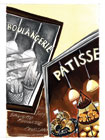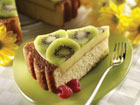
“Individual portions are the hottest trend in the dessert category,” says Bob Barry, vice president of sales and marketing at Atkins International Foods.
Many experts suggest that, like Badaracco, restaurant guests are more inclined to order smaller portions. “Season's 52, which offers individual servings of classic desserts at a reduced price, is having a record success in [dessert purchases],” informs Barry. “Current [dessert] sales for this concept are way ahead of most restaurant chains; smaller portions and some unique flavors give guests a chance to have that sweet ending to their meal.”
Rocky Run, a small chain in Maryland, currently sells 2,500 individual portions of a sampler (brownies and cheesecake), compared to 150 portions of sliced cakes per week.
Entire restaurants solely dedicated to cupcakes are opening around the country. This phenomenon has caused a crop of new restaurants along the coasts, including Citizen Cupcake Cafe and Bar in San Francisco, where they serve martinis with cupcakes, and the Cupcake Station in Birmingham, Mich. In some cases, dessert bars become late-night destinations, places theatergoers and late night revelers seek for after-event indulgences.

PHOTO COURTESY OF THE WISCONSIN MILK MARKETING BOARD INC.
“Desserting” Sweets
Barry suggests that simplicity may be a new theme that will cause chefs to use fewer ingredients and to focus on good, clean flavors like apple, green tea, pumpkin and ginger. He expects ingredients that merely look nice, but do little for the palate, will be cut from the rotation.The simplicity trend also stems from a desire to remove processed sugar and flour and add whole grains and whole wheat into foods. Whole grain is making headway in cobblers, crisps and cakes. Barry also advises that restaurants will begin serving some desserts that are less sweet.
“Very light sweeteners can be used in frostings and whipped cream or combined with fresh fruits and honey to let the natural sweeteners make the statement,” he describes.

Tasting Taboo
“Chefs are layering flavors in desserts just like in the main course,” comments Michael Morrison, a senior executive chef at a flavoring company. Butter and lard are becoming standard ingredients again, because food manufacturers are trying to reduce the amount of trans fat in their products. Dishes with butter sauces, like Maple Butter Brownies at Applebee's, have become more prominent.Chocolate Shanghai Soup Dumplings can be found on the menu at the Rickshaw Dumpling Bar. Described as a melted chocolate in a black sesame mochi wrapper, the dessert/soup is high in butterfat but tastes amazing, according to Badaracco.
“Taboo foods are making a come-back,” asserts Badaracco. Taboo foods are those frowned upon due to health reasons, or because they contain allergens. Salt, butter, lard or peanut butter fall into this category of foods.
Peanut butter is one taboo ingredient that people consider to be a comfort food. It is traversing menus at Applebee's and Red Robin's, and it is showing up on many mid-level and high-end restaurants' menus. For example, salted peanut butter shortbread with peanut butter ice cream and peanut crunch can be found at Veil, a fine dining establishment in Seattle. Le Bernardin in New York serves a milk chocolate pot de crème topped with a pinch of Maldon sea salt and is served in a decapitated eggshell.
Chile peppers, thyme and rosemary are being used in lime desserts. At one point, WD50 in New York City served mustard and cumin ice cream flavors. Room 4 Desserts, a desserts-only restaurant, experiments with tarragon, apricot salt and other savory flavors. Barry has noted the appearance of beet cakes, beet caramel and even Parmesan ice cream on some menus.

PHOTO COURTESY OF KRAFT FOOD INGREDIENTS
International Sweets
Badaracco believes that the sweet and savory trend is a natural progression that occurred because there have been more savory flavors in the spotlight. “South American countries, specifically Argentina, have always mixed savory with sweet,” says Badaracco. “Thyme and lemon have been used together forever. American chefs like to play with extremes sometimes, and these flavoring concepts are experimented with because of the popularity of Latin flavors.”Peruvian, Argentinean, Chilean and Cuban flavors are hitting dessert menus because typical flavors like coconut, flan, coffee and cocoa notes already are on American minds. The popularity of wines imported from Chile and Argentina has a lot to do with the influx of desserts from those countries. “Once wines come into the U.S., chefs want to start serving them with the authentic flavors and desserts from that country,” informs Badaracco.
Adding an ethnic flair to a product may be as simple as adding a little heat to the chocolate, offers Morrison. For example, many foodservice manufacturers have sold molten lava cake, but they can customize it by adding chipotle to the base and/or topping it with a Caribbean caramel sauce.
Adding tequila lime cream cheese sauce to create a coconut ginger cheesecake can accomplish the same objective, observes Morrison. Hard to find exotic items such as crystallized ginger, rose petals and lychee fruit are examples of premium items that are found more often in desserts. “We are also seeing more sorbets and ice creams popping up with the use of exotic flavors,” says Morrison. Tropical “superfruits” may become trendy dessert flavors, because their stars are rising in the nutraceutical realm.
Desserts and flavors from Turkey and Russia may start to influence menus. Turkey is known for figs and apricots. Both flavors are becoming more popular on many menus.
“Different versions of baklava (a pastry made with layered phyllo dough) have sat quietly on menus forever, but they are being reawakened because the use of regional honeys is extremely hot,” says Badaracco. The honey trend has become a springboard to create new avenues for traditional desserts.
Although it is a fringe trend, Badaracco suspects that camel milk ice cream, which is new to the United Arab Emirates, will catch on in the U.S. The United Nations Food and Agriculture Organization (FAO) also predicts more uses for camel dairy products, stating in a press release that its potential is “massive.”
Regionally Ethnic
Restaurants are starting to exploit regional fruits, a trend that can give a dessert an upscale edge. Restaurant patrons are becoming more educated about not just the fruit, but also the varietal of fruit. They want to know where it is coming from, and if it is more highly prized than others of its kind. In Washington State, restaurants are serving Fuji apples to make apple pie, but in New York State, they may use Wine Sap or Northern Spy apples.Many of these trends are influenced by consumers' desire to patronize companies that practice sustainability and use local ingredients. Conversely, they also want global flavors. Some restaurants are remaining loyal to the local cultures and ethnicities in a region. For example, the Cuban culture is predominant in Florida, the Midwest has a deep Russian and Ukrainian history and the West Coast is entrenched in Japanese and Asian influences.
Championing the Chocoholic
“Whether it's a warm chocolate lava cake or hot fudge brownie ala mode, chocolate is still on top,” offers Morrison. Chocolate still ranks first, but consumers are looking for the high-end chocolate, and restaurants are pairing it with unlikely ingredients.
Room 4 Dessert offers a curry-spiced chocolate parfait, Trumbolt Kitchen in Connecticut serves Ancho Chili Flourless Chocolate Cake and Guilt Chocolates, in New York, has an Ancho Chili Parfait.
White chocolate also is becoming a favorite. Literati II in Los Angeles has a chocolate truffle layer cake with white chocolate ganache and Meyer lemon. Customers lounging at Mercers in Manhattan can sip white chocolate margaritas with white chocolate mousse, among other drinkable desserts.
The Fruit Debut
It is always fun to watch a combination of two trends merging, says Badaracco. The search for premium and fresh ingredients is inspired both by health-conscious consumers and by the trend towards premiumization.Health is a major reason that desserts are slimming down. However, besides portion control and fruit additions, dessert is still considered indulgent. “The focus on health and wellness has not had a long-term impact on the dessert category,” says Darren Tristano, executive vice president at Technomic. “People's ordering habits haven't changed that much, even though they say they would like to eat healthier.”
Tropical fruits, like pomegranate, tamarind and guava, were already hot, but operators are serving them with a twist. The global barbecue phenomenon, which is especially big in Korean and Turkish cuisine, has chefs exploring roasted fruits. “They are grilling peaches and pineapples or creating fruit kabobs, and those become the dessert,” says Badaracco.
Beverage Flavors
The use of beer in desserts is a fringe trend that is hitting mid level restaurants. Some desserts come with a wine sauce. Similarly, just as wine is paired with certain foods, the press has reported food pairings with beer, notices Badaracco. The beer trend is bubbling into chocolate cakes made with stout, such as the one served at Rogue River Brewery in Oregon.Similarly, tea recently has been paired with desserts as a beverage, such as at Room 4 Dessert, but now it is also being used as an ingredient. Teas are showing up in cakes and sauces. “Tea is being touted as the next coffee,” says Badaracco.
Plate-scaping
“Dessert portions may be getting smaller, but the plate is larger, with more garnish and pizzazz,” says Morrison. Operators want the option to customize their desserts. Customization might require warming or flaming at the tables or adding a house sauce. “Tableside flaming has had a comeback and is popularly used to make Bananas Foster, Cherries Jubilee and Strawberry Grand Marnier.”“The more the customer thinks that the restaurant is making the dessert in-house, the better it sells,” adds Morrison. Offering premium desserts may mean spending time to source exotic fruits, ethnic flavor profiles and premium preparations, but the end result should always be a pleasurable indulgence.
Website Resources:
www.culinarytides.com -- Culinary trends forecastingwww.KraftFoodIngredients -- Information about grill flavors and other indulgences
www.atkins-intl-foods.com -- Dessert trend information
www.menuinsights.com -- Foodservice database and trend reports
www.technomic.com -- Foodservice marketing and trend information